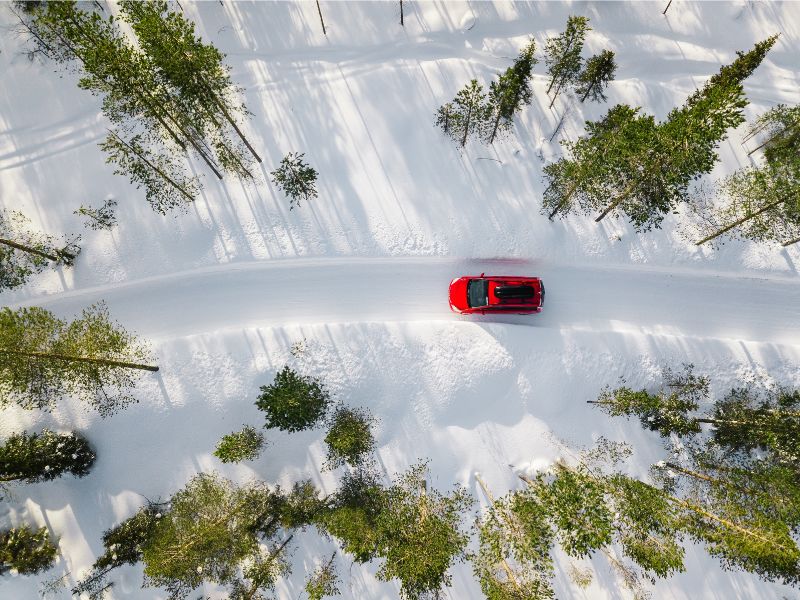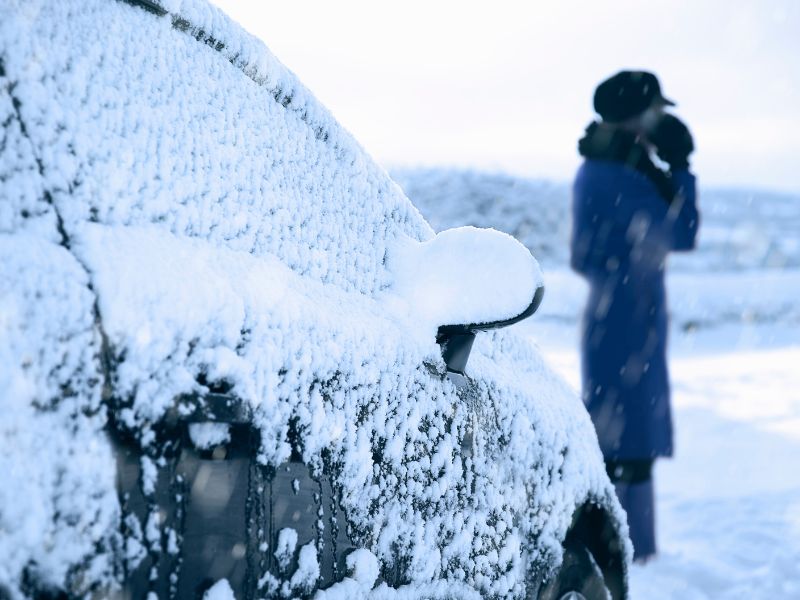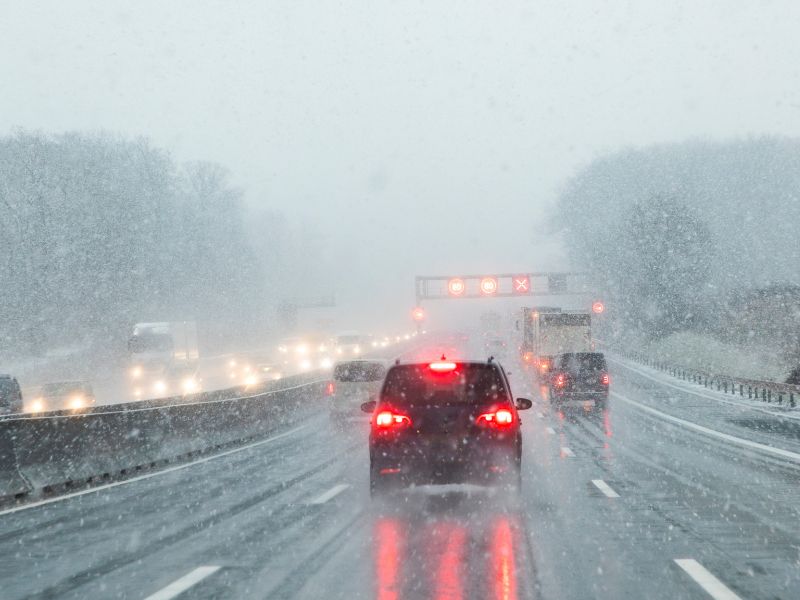Maryland Winter Driving Tips: Navigating Snowy Roads
- Home
- Blog
- Auto Accident
- Maryland Winter Driving Tips: Navigating Snowy Roads
On average, Maryland receives between 20.6 and 110 inches of snow annually, depending on your location within the state. Driving in snow is dangerous, no matter the amount. When it melts and refreezes overnight, the ice the following day is also hazardous for both experienced and novice drivers. Overall, 24 percent of all accidents are weather-related, and 15 percent of weather-related accidents are from snowy conditions. Below we provide tips on how to stay safe in the winter. If you are in an accident, contact our personal injury attorneys at Bowers Law for legal advice as soon as possible. You can text or call us at 667-220-6500 or use our online contact form.

How to Prepare for Driving in the Snow in Maryland
There are beneficial ways to prepare yourself and your car for driving across snowy terrain. Consider the following safety tips and implement them before the next big snow arrives.
Winter Emergency Preparedness
Make your motto “be prepared” as winter heads your way. To prepare for emergencies, set time aside to gather emergency preparedness items to carry in your vehicle. These items can help you handle common issues when driving in snow and keep you safe in an emergency.
Keep the following emergency preparedness items in your vehicle.
- Ice scraper
- Small broom to clear snow piled on windshields
- Snow shovel
- Kitty litter or sand in case you become stuck in the snow
- Flashlight
- Flares
- Jumper cables
- Warm blankets, food, and water
- Cell phone, fully charged, and a car charger
- First aid kit
Plan Out Your Route
Winter weather conditions can often delay a trip. To help with this, start by planning out the best route to your destination.
Study maps and directions to gain a sense of where your route takes you and what other alternatives might be available if needed. Check weather forecasts and road conditions often to know as much as you can about what to expect. Start each trip with a full gas tank in case traffic becomes backed up or you have difficulty finding and reaching an open gas station. Finally, let someone know what time you are leaving and what time you expect to arrive at your destination.
Service Your Vehicle Before Winter

Take your vehicle in for service by a certified mechanic before the first snow is forecasted. As part of this pre-winter service, have your car undergo routine maintenance, such as a tune-up. Also, ask your mechanic to give it a once-over to detect any leaks, faulty parts, or potential problems. Check coolant and other fluid levels, hoses, and belts often during the snow season. Regularly check that your defroster, heater, and windshield wipers work well.
Check Your Battery
As the temperatures begin to fall, battery power in your vehicle is affected. Start out the winter months with yours in good condition. Have it checked for sufficient voltage, and also ask your mechanic to inspect the charging system and belts. If needed, replace your battery or make other repairs. Starting your vehicle in cold weather requires more power, and extreme cold can sometimes cause a battery to fail.
Check Your Tires
Check your tires before the winter snow season. Start with checking the pressure, ensuring they are properly inflated to match the manufacturer’s recommendations. Also, visually inspect tires, looking for any uneven wear, insufficient tread, or other issues. Decide whether to use winter tires or not and, if so, have them installed to help with traction and provide more stability in winter conditions.
Cold weather can affect tire pressure, making your tires unfit for winter driving and leading to faster wear and tear. For these reasons, make it a habit to check your tires during the snow season regularly.
Maryland sees its fair share of snow most winters, and following these safe winter tips can help you prepare and stay safe.
What Are the Best Ways to Handle Driving in Snow?
Whether you regularly drive in inclement weather or unexpectedly find yourself out in the snow, you must stay safe. Here are some driving tips for handling your vehicle in the snow.
Drive Slowly
Roadways can become covered in snow or turn icy, producing a dangerous environment for you and the other vehicles on the roadway. The snow also causes your tires to have less traction. To stay safe, drive slower, going several miles under the speed limit.
Also, always slow down as your approach ramps or bridges, as these usually are the first to freeze and may be challenging to navigate. Leave early and allow for extra travel time to get to your destination.
Provide Distance Between Vehicles
While providing distance between vehicles is always recommended when driving, it is even more critical in bad weather and snow. Double your braking distance, as packed snow or ice will create slippery roads, making it harder to brake suddenly to avoid collisions.
Snowplows and other road maintenance vehicles will also be out on the roadways. Increase your distance and give them as much room as possible.
Do Not Slam on Your Brakes
When you need to slow down in snow or on icy roads, use your brakes gradually. Avoid slamming your brakes, even if you go into a skid. Instead, to recover from a skid, ease off the gas pedal and steer in the skid’s direction until you can regain traction or stop the vehicle altogether.
When is the Best Time to Drive in the Snow?
Snowfall is rarely convenient to your schedule, so knowing when the best times to drive in it can be helpful. Consider visibility first. When driving in sleet or snow, you will have higher visibility during the daylight hours. So, if a snowstorm is forecasted for late in the day or snow continues to fall day and night, try to complete your drive during daylight hours.
Also, fresh snow is easier to drive in because you will have more traction. However, as it continues to fall, it becomes packed, resulting in slick road surfaces, which can be dangerous.
What Should You Do If Your Car Becomes Stuck in the Snow?
Driving on snowy roads can be challenging. If you are stuck in the snow in your vehicle, and the conditions are worsening, you should know what to do.
Stay in Your Vehicle
The safest place to be when stuck in the snow is in your own vehicle. If you wander outside, you may have to deal with high winds, extreme cold, and low visibility that can cause you to lose your way or put you in harm’s way from other vehicles. Instead, wait inside your car for help to arrive.
Clear Your Exhaust Pipe
Exit your vehicle occasionally and clean out the exhaust pipe. Doing so can help prevent carbon monoxide poisoning when you run your vehicle to keep warm.
Run the Car Sparingly
Only run the car sparingly when stuck in the snow. For example, run it for ten minutes at a time every hour to warm up the car’s interior. Be sure to crack open a window to allow in fresh air and avoid carbon monoxide build-up.
Make Yourself Visible to Rescuers
To help rescuers find you, make yourself visible by keeping the interior dome light on whenever you run the engine. Also, place a bright-colored cloth or some type of marker outside on your window or on an antenna or other feature on the vehicle’s exterior to signal that someone is inside.
Common Hazards Caused by Snow in Maryland

Winter weather in Maryland brings with it various problems for motorists. As temperatures plummet and snow begins to fall and pile up, the following common hazards can occur.
Dangerous Ice
Ice is dangerous on roadways, causing loss of traction and slipping. You will need to slow down, brake softly, and avoid making many sharp turns. Be especially alert on ramps and bridges, as dangerous ice builds up faster in these places.
Poor Visibility
Visibility can quickly deteriorate when temperatures drop and snow begins to fall. Frost, ice, or snow can build up on your windshield, and your wipers can become frozen. To avoid this buildup, regularly inspect your windshield wipers to ensure they are intact and functioning. Check wiper fluid levels regularly. Run your vehicle’s defroster constantly while driving and turn on your headlights so other drivers can see your car.
Heavy Snow
Heavy snowfall impedes visibility. It can also hide potential road problems, such as potholes or black ice. Maryland drivers can increase their safety by checking local forecasts and road condition updates.
Do You Need an Attorney After an Icy Car Accident?
Suffering a car accident can be difficult and overwhelming at any time. When hazardous winter weather plays a role, it can also be devastating, resulting in severe injuries, lost time from work, and more. Working with a dedicated auto accident lawyer can be beneficial. They can help you by negotiating with insurance companies, proving negligence on behalf of another, and obtaining deserved compensation.
If a car accident occurs, and you were not at fault due to a winter storm, contact our attorneys at Bowers Law for legal advice and help to determine what steps to take next. In most cases in Maryland, you have three years from the initial accident date to file a personal injury case. However, there are exceptions to this, and in certain circumstances, the deadline is earlier. You also may need to give proper notice to be eligible for recovery. Our attorneys can determine if this notice is necessary in your case and guide you through these complex situations.
Did Snowy Weather Cause Your Accident?
Driving on roadways is already challenging enough, but factor in winter weather, and the chances of an accident increase. If you are injured in a winter-weather car accident, contact our dedicated lawyers at Bowers Law. You can reach us by texting or calling 667-220-6500 to schedule a consultation, or use our convenient online contact form to get started.

Written By Jobeth Bowers
Maryland Attorney Jobeth Bowers is the founder of Bowers Law and a graduate of the University of Baltimore School of Law
"*" indicates required fields







